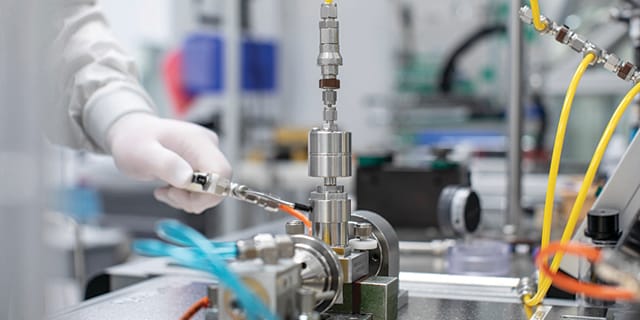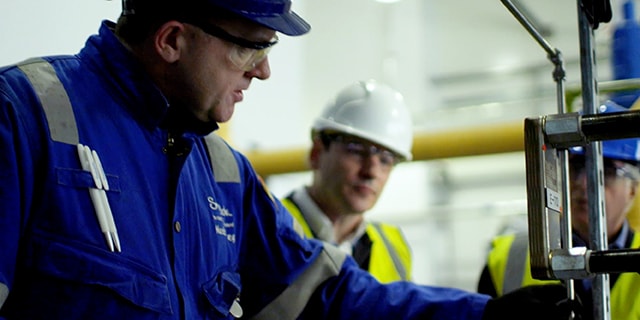Solving ALD Semiconductor Processing Challenges

How to Solve Top ALD and ALE Semiconductor Processing Challenges
In the highly precise world of semiconductor fabrication, some essential fluid system component qualities are the cost of entry. In atomic layer deposition (ALD) and atomic layer etching (ALE) processes, for example, extreme cleanliness—while increasingly difficult to maintain as process nodes get smaller and smaller—is critical from any component used in these systems. Leak-tight performance is also a must, as many of the gases used in production process fluid systems can be hazardous.
These conditions may seem to indicate that the market for valves, fittings, and other critical fluid system components in the semiconductor world has become somewhat commoditized. Since all options must provide these essential characteristics, end-use performance levels across them can be expected to remain relatively the same—right?
Not necessarily. Ultrahigh-purity valves for ALD semiconductor processing are not all created equal, and some advanced options have the potential to help fabricators overcome some of their most pressing challenges. Below, we examine the top three challenges semiconductor fabricators encounter and how the right ALD process valves and other fluid system components can help you address and overcome those challenges more confidently.
#1. Handling Unstable Chemistries
As noted, many of the precursor gases common in ALD and ALE production processes are often unstable and hazardous. While leak-tightness is essential in valve performance, there are additional characteristics to look for.
For example, to manage precursors more effectively and to explore the use of novel ones, you may need to subject your process valves to widely varying pressures and temperatures as you pursue consistent, repeatable, gaseous-state flow. This means valves must perform predictably and reliably across a wide range of system pressures and temperatures, including up to 200°C.
In addition, ALD valves and ALE valves must perform the purging processes within the same precise parameters as the initial chemical dosing. This two-step process involves the purging of the precursor gas with nitrogen, which then needs to be purged as well. This needs to occur quickly and consistently to keep production as efficient as possible.
Valves must perform predictably and reliably across a wide range of system pressures and temperatures, including up to 200°C.
Mitigating the effects of fluctuating extreme temperatures and more effectively purging can be accomplished with certain available multiport valves and multivalve manifolds. Your choice between these two options is entirely application dependent—manifolds are typically more appropriate for applications where higher volumes must be purged. But either can be an advantageous option as you seek to contend with the unique challenges of new chemistries.


#2. Maximizing Yield
Today’s fabs are focused on one thing above all: maximizing the volume of viable chips they can produce during a production cycle.
While speed is important, consistency and repeatability are even more critical. ALD and ALE processes often involve millions of chemical doses to complete. Specialized process valves are tasked to consistently deliver those doses reliably, often over many millions of cycles. The volume of these chemical doses can be influenced by the process valve flow capacity but are more impacted by the milliseconds in which the process valve is open. Small variances in valve actuation response time can lead to unexpected changes in the amount of chemical delivered to the process chamber.
Small valve actuation response time can lead to unexpected changes in the amount of chemical delivered to the process chamber.
There are a few optimal metrics to look for in a process valve designed for consistently high performance:
- Valves should provide optimal performance in process temperatures as high as 200°C In some processes, it is helpful if they can be fully immersed in the gas box to provide precise control over the dosing and purging of process gases
- They should offer high, consistent flow to ensure conformity with production standards. This flow needs to be tightly controlled and precise to stay within strict process tolerances—so valve response and actuation speeds need to be as fast as possible.
- Valves should deliver the same level of performance across millions of cycles
#3. Reducing Total Cost of Ownership
Finally, lowering total cost of ownership for semiconductor tools is an important part of operational efficiency. Achieving this goal involves reducing any potential downtime wherever possible.
Use of hazardous and corrosive precursor gases, as well as severe temperature and pressure fluctuations, necessitates that your valves are designed and manufactured specifically for ALD/ALE systems. Design considerations should include the valve’s materials of construction. A stainless steel formulation with an optimized balance of high-performance alloys and residual content is critical for semiconductor production environments. Elevated levels of chromium, nickel, and molybdenum in stainless steel formulations will help increase both the material’s strength and ability to withstand corrosion. Certain residual content must also remain in the formulation, including a specific balance of sulfur to ensure optimal end-use component surface finishing and weldability. Your manufacturer should be able to balance these critical performance attributes to suit application requirements.
Optimized material selection can contribute to extended component service life, helping to reduce downtime for maintenance, repair, or replacement. Every moment of downtime represents significant cost and loss of potential revenue. Considering the critical role that valves play in ALD and ALE processes (and their low cost relative to the entire system), investing in higher-performing fluid system components can yield a significant return on that investment.
Working with the right supplier to procure high-quality, highly reliable ALD and ALE process valves is important as well. Ideally, your supplier will demonstrate an understanding of atomic layer processes and their inherent complexities and can help guide you toward the right valve selection for your needs. Our semiconductor specialists have extensive experience helping semiconductor tool manufacturers and chip fabricators evolve their production processes and equipment. If you are interested in learning more about how to optimize your processes, our specialists are ready to start a conversation.
Related Articles

One New Valve. Three Reasons It Could Change Semiconductor Manufacturing
Find out how the latest innovation in atomic layer deposition (ALD) valve technology is changing the game for high-tech semiconductor manufacturers.

Why Fast Support Matters for Semiconductor Fabs
Reducing total cost of ownership for semiconductor fabs is possible by working with suppliers that can provide fast, local support for critical challenges. Find out how Swagelok can help.

Building More Profitable Semiconductor Fabs
Learn why choosing high-quality fluid system parts and assemblies can contribute to faster semiconductor fabrication facility construction, and lower total cost of ownership over the facility’s lifetime.

